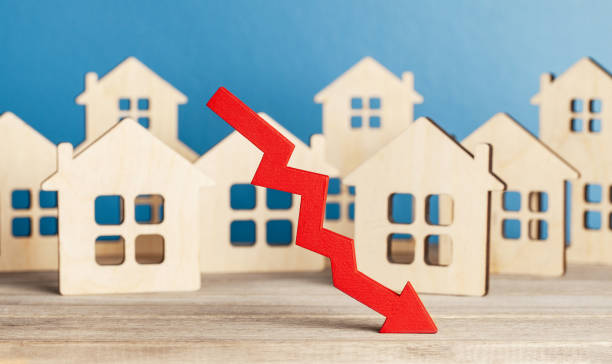Any period of economic uncertainty can make a major financial decision, like buying a house, more stressful. Even times of economic confidence can seem like the perfect time for the bottom to fall out, and you don’t want your home to be collateral damage.
While the housing market on a national scale has seen prices decline since mid-2022 amid high-interest rates, experts are noting that a sudden and abrupt housing market crash is unlikely, based on current market conditions. Housing demand, housing supply, mortgage interest rates, and unemployment all play a role in how the real estate market fares, and currently they indicate a period of decline in some markets and growth in others, but a decline in transactions overall – and certainly not significant decline as seen in the housing market crash of 2008-2009.
Are We in a Housing Bubble?
In economics, a bubble is defined as a period of rapid market value growth of an asset – in this case, homes.
Considering the fast pace of the housing market that has lasted roughly the length of the COVID-19 pandemic, rapid market value growth accurately describes the housing market up until about midway through 2022. Home price growth was in the double digits year over year every month from August 2020 thru mid-July 2022, based on home sale price data from Redfin.
Signs of a growing housing bubble may be waning now, however. Month-over-month prices have declined since the summer of 2022. And while home prices are still up year over year as of January, the increase was just 1.5% higher than January 2022, according to Redfin.
“We’re looking at home prices right now and think they’re a bit overextended, still, of what they should be, given mortgage interest rates,” says Mike Reynolds, vice president of investment strategy at Glenmede, a wealth management firm headquartered in Philadelphia.
While mortgage rates are technically independent of the federal fund’s target rate set by the Federal Reserve, they often increase or decrease as a result of the Fed’s actions. The federal fund’s target rate has been raised repeatedly in the last year in a marked effort to curb inflation. The average 30-year, fixed-rate mortgage interest rate reached more than 7% in October and November 2022 but dropped close to 6% in January. The average interest rate is showing some volatility now, and as of Feb. 23, the average rate is 6.5%, according to Freddie Mac.
“The second half of last year was a very soft phase for homebuying demand, it kind of seemed like homebuyers reached a breaking point right in early summer thanks to affordability challenges,” says Jeff Tucker, senior economist for Zillow.
An easing of mortgage interest rates in January encouraged some buyers to come back to the market – Zillow’s January 2023 market report that newly pending listings in January were only down 20% compared to January 2022, an improvement compared to November, when newly pending listings were down 38% year over year. The more volatile mortgage interest rates may see some buyers backing off the market again if they continue upward.
Current homeowners still don’t appear eager to sell, however. The supply of houses on the market, which has been a major cause of fast-rising home prices even before the pandemic, remains low as homebuilders back off plans for major development – homeowners are choosing to stay in their current homes rather than take on a higher mortgage interest rate.
Tucker points out that volatility among mortgage interest rates could lead to some back-and-forth with homebuyers – the uptick in rates in the second half of February could result in buyers once again backing away from house hunting.
A lack of demand will ultimately lead to declining year-over-year home prices, but that doesn’t necessarily mean the housing bubble will burst. Reynolds speculates that a return to equilibrium, where homes are priced accurately to buyer affordability, is more in line with what he expects.
“It’s possible a little bit of air gets let out of this bubble, but an outright burst is unlikely this time around,” Reynolds says.
The decrease in the number of home sales since interest rates initially rose is stark. In January, there were more than 34% fewer homes sold than in January 2022, according to Redfin.
But the ability for homeowners now to wait out economic uncertainty – and climbing interest rates – may be what keeps any drop in home prices from becoming more concerning. Even with the year-over-year increase in pending deals, based on Zillow data, Tucker notes that existing homeowners don’t appear willing to sell their homes yet.
Markets that experienced faster home price growth in recent years are more likely to see bigger dips as prices correct to fit with long-term demand, says Jarred Kessler, founder and CEO of EasyKnock, a company that provides an alternative to home equity loans. He expects to see the markets where prices shot up high and faster than others – such as Austin, Texas; Nashville, Tennessee; Miami; and Phoenix – as places more likely to see prices decline 10% or more.
“(Prices) moved up so much, and a lot of those places had a lot of institutional buyers, and they’ve pulled back now,” Kessler says. Real estate investors looking to make large-scale profits from buying single-family homes and flipping them, often referred to as iBuyers, in many of the most popular markets have slowed business or stopped altogether.
Homeownership can feel scary during any point of economic uncertainty – especially if you have a vivid memory of the Great Recession and the housing market crash of 2008 and 2009. Predatory lending practices in the first years of the 21st century meant many homeowners faced foreclosure when adjustable interest rates rose, and unemployment further increased the number of properties in foreclosure.
Housing demand was artificially propped up by issuing mortgages to people who weren’t in a good financial place to buy and maintain a home, and the economic downturn also meant buyer demand plummeted. Home values declined significantly as a result.
The current situation is very different compared to the Great Recession, says Rick Sharga, executive vice president of market intelligence at real estate data company ATTOM, based in Irvine, California. “Mortgage delinquency rates are actually lower than they were prior to COVID,” he says, noting that 2019 was in itself a mild year for foreclosure activity, historically speaking.
“Ninety-three percent of borrowers who are in foreclosure today actually have positive equity in their homes, … (which) gives these distressed homeowners a couple different options for a soft landing,” Sharga says.
Reynolds points out another major difference between today’s market and the housing crash is the issue of supply – excessive building leading up to 2008 meant that when demand dropped, there were entire housing developments that sat vacant. Cut to 2023, housing is still catching up on the low rate of building compared to household formation since the Great Recession. “There are fewer homes per household than there was back then,” Reynolds says.
With today’s homeowners, laws and regulations have been in place to prevent predatory lending since the Great Recession. Even as high home prices and rising interest rates have increased the total cost to buy a home, making homeownership unaffordable for otherwise would-be homebuyers, there are still more qualified buyers searching for homes than there are properties for sale.
All these factors combined, and Reynolds says he and his colleagues agree that “a crash at this point is unlikely.”
As of December 2022, the U.S. Census Bureau’s Building Permits Survey reports there were 50,200 building permits filed in the U.S., far below the forecast of 68,800 permits predicted for that month. Still, it’s well above anything compared to the Great Recession: After the housing bubble burst in 2008, building permits for single-family detached homes cratered to a low of 22,100 in January 2009.
In a typical year, the number of building permits bottoms out in December and January then steadily climbs until peaking in the spring and summer months. U.S. News’ Housing Market Index forecasts a peak of nearly 78,000 building permits in March 2023. Compare that to March 2022’s peak of 107,4000 – which was also the highest month for the number of building permits filed in all of 2022. With far fewer permits already, expect new home construction to slow.
Builder sentiment is also down to 42 out of 100 as of February 2023 – a steep decline from 84 in December 2021, but a month-over-month increase from 35 in January 2023, according to the National Association of Homebuilders and Wells Fargo Housing Market Index. Builder sentiment is based on the number of new single-family homes, predicted single-family homes in the next six months, and overall traffic of buyers.
In short, builders don’t feel like they’re going to be building many new construction homes for the foreseeable future. But that doesn’t indicate the housing market is going to crash or that a housing bubble will worsen. In fact, they may be helping to avoid future problems.
“Incredibly limited supply is keeping a floor under prices – that shows sellers are really willing to hold onto what they’ve got,” Tucker says. “That does kind of prevent runaway declines in prices.”
At least two consecutive quarters of negative GDP growth make a recession, and it’s typically accompanied by an increase in unemployment and a decrease in consumption by the general public.
The financial strain individuals face during a recession leads to a slowdown in the housing market – homebuyers may pause their search if they’re worried about layoffs, and there may be a slight increase in foreclosure activity while higher unemployment increases the number of people who can’t pay their mortgage.
However, once activity on the housing market slows enough, mortgage interest rates drop to a point where buyers re-enter the market, interested in getting a good deal. Unlike in the Great Recession, an increase in housing market activity helps to bring the economy out of recession.
The real GDP increased in the last two quarters of 2022 – by 3.2% in the third quarter, and 2.9% in the fourth, according to the Bureau of Economic Analysis. Additionally, unemployment remains low at just 3.4% in January, according to the Bureau of Labor Statistics. While these indicators show no recession right now, the Fed’s actions throughout 2022 lead most experts to agree that a recession is likely in 2023.
“I think it’s going to be a short recession … but it’s going to be a recession,” Kessler says.
While current conditions don’t point to a housing market crash, there’s no crystal ball to guarantee how the economy will fare in the next few months or years.
A few factors that could make the housing market more unstable include:
- Unemployment. A slight increase in unemployment would be OK, but a bottom fallout could be an indication of danger for the housing market. If too many people are without work, then distressed home sales climb and foreclosures become more likely.
- Homebuilding. Builders have been plagued with labor shortages for a decade, and the availability and cost of materials have been an ongoing issue since the start of the pandemic. With the slowdown in buyer activity, homebuilders are pulling back and there are fewer permits for new housing construction. That can prolong the housing shortage, drawing out the demand-supply imbalance.
- Buyer demand. Housing markets have cooled slightly, but demand hasn’t disappeared, and in many places remains strong largely due to the shortage of homes on the market. If buyer demand completely disappears, it would be a sign of a problem.
- Homebuyer motivation. For the typical homebuyer, now is not the time to buy real estate with the expectation of seeing value double in a short period of time. Kessler advises buying with the plan to live there for at least five years. “If you can afford to live there, don’t worry about the noise between now and then,” Kessler says.
Clarified on Aug. 10, 2022: A previous version of this story was not clear that Reynolds works in wealth management for Glenmede.









